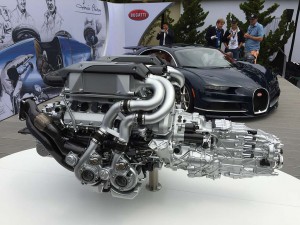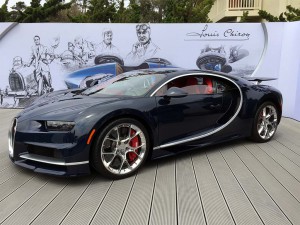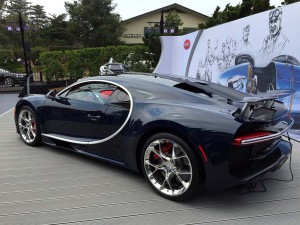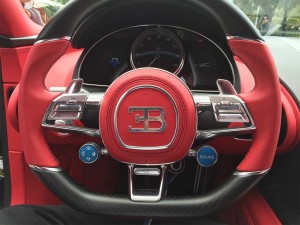While it officially debuted at the Geneva Motor Show last spring, Bugatti has been keeping the new Chiron ultracar largely under wraps ever since.
But the Volkswagen AG maker brought the Veyron successor out, appropriately enough, for this year’s Pebble Beach Concours d’Elegance, and we finally got the chance to check it out up close – and with the help of Chiron Chief Engineer Willi Netuschil.
While the Chiron picks up on key styling cues of the brand’s previous exotic, the Veyron, Netuschil made it clear that it is anything but a carryover. A closer look, he explained, reveals the significant updates made to ensure that Chiron can deliver a whopping 25% more power than the old Bugatti, something that should help it regain a number of world records, including power, torque and top speed.
“This was a very, very big challenge,” said the German engineer who started out as an auto mechanic, taking an unusual route to leading the development of the world’s fastest automobile. He briefly worked at Mercedes before joining VW on its heavy truck program. Immediately before taking on the Chiron project four years ago, Netuschil was working on the Amorak, VW’s midsize pickup.
“The previous car was the pinnacle, but now we had to top that,” he explained as he walked over to a Bugatti Chiron hidden in a courtyard by the Lodge at Pebble Beach. The one thing that he and his team members were told to eliminate from their vocabulary was the word, “impossible.”
(Rare barn finds among the highlights at 2016 Pebble Beach Concours. For more, Click Here.)
Surprisingly, getting 1,500 horsepower and 1,180 pound-feet of torque out of the Chiron’s 8.0-liter quad-turbo W-16 engine wasn’t considered the biggest challenge. The real obstacle was finding ways to cool both the engine and the massive brakes needed to slow down a car with an estimated top speed of 420 kmh, or just over 260 mph.
It will need to hit at least 261 mph to regain the world speed record for a production vehicle.
A closer inspection of the Chiron’s ultra-light carbon-fiber body reveals the solution – or solutions, if you prefer. There are any number of air intakes, including ones next to the headlamps, along the grille and below the bumper, to cool the huge front brakes – which each use eight pistons. There are twin intakes built into the body, the upper half feeding the engine, the lower ports providing still more cooling for the rear six-piston brakes.
Those pistons, incidentally, are made of titanium, part of the broader effort to maintain the 4,390-pound mass of the old Veyron – a target Netuschil claims his team hit.
Carbon fiber and composites make up the vast majority of the body and chassis, with the notable exception of aluminum crash structures at the front and rear of the Bugatti Chiron.
(Click Here to check out the McLaren 570GT by MSO Concept debuting at Pebble Beach.)

It's this 8.0-liter, W16 engine that puts out the 1,500 horsepower that drives the new Chiron over the 260 mph mark.
In a first, the engineering team even came up with a way to use carbon-fiber components, such as the intake runners and manifold, on the engine. Beyond saving weight, the smoother surface improved airflow, according to the chief engineer.
Airflow, at the speeds the Chiron will operate, is pretty much everything. Attack the wind the wrong way and it will slow you down – or toss you out of control. Getting aerodynamics right came down to the subtlest of details. There are small flaps on the big wheels, for example, to further improve cooling and to reduce drag around the “dirty” wheel wells.
There’s also a large, adaptive rear spoiler that adjusts its position depending upon factors such as the speed of the vehicle and the mode the driver has set it in. These include a cruising mode, an Autobahn mode and, with the right key, a speed-record mode. If you don’t hand that special key to your kid or the valet, sadly, they will be limited to keeping the Chiron down to a mere 380 kmh, or 236 mph.
The development team actually tried to improve drivability of the Chiron, as well as its performance. They also made sure to keep a driver’s attention focused, as much as possible, on the road. There are none of the big video screens you find in so many of today’s cars, even high performance vehicles. Instead, there is a large speedometer centered behind the steering wheel, with two modest LCD displays framing it. The left handles vehicle-related functions, the right navigation and infotainment.
Key vehicle controls are mounted on the steering wheel, secondary controls for things like climate control rise up, single file, on the center stack.
The simple message of the Bugatti Chiron, inside and out, is that, “design follows performance,” explained Netuschil.
As with the Veyron before it, Bugatti officials acknowledge they will likely offer a series of updated variants during the Chiron’s lifecycle. If the old model is any indication, we’ll see an open-top version, as well as still more powerful and faster packages. But what’s on tap next, Netuschil cautioned, “We haven’t decided yet.” The first goal is to get the basic Bugatti Chiron on the road.
(Cadillac Escala Concept reveals new design direction for Detroit brand. Click Here to check it out.)
That will happen later this year at a price tag expected to start at around $2.6 million, or nearly double what the original Bugatti Veyron went for.




Christmas is coming, hint, hint.